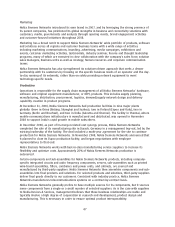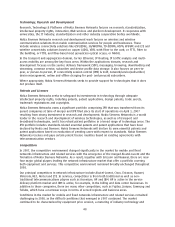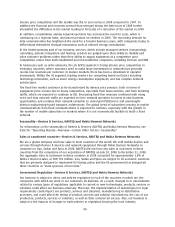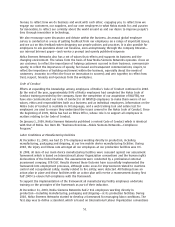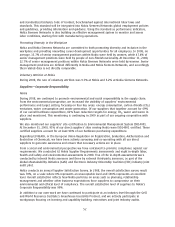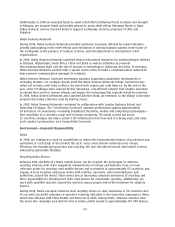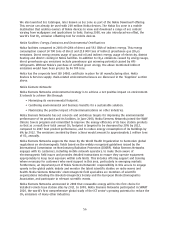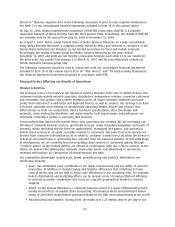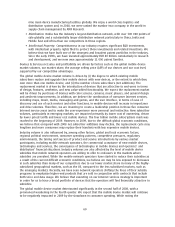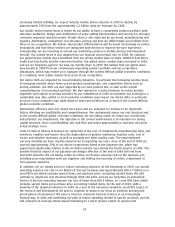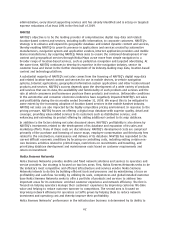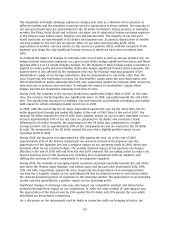Nokia 2008 Annual Report Download - page 57
Download and view the complete annual report
Please find page 57 of the 2008 Nokia annual report below. You can navigate through the pages in the report by either clicking on the pages listed below, or by using the keyword search tool below to find specific information within the annual report.We also launched Eco Catalogue, later known as Eco zone as part of the Nokia Download! offering.
This service can already be used with 200 million Nokia devices. The Nokia Eco zone is a mobile
destination that enables owners of Nokia devices to view and download a range of eco content
varying from wallpapers and applications to links. During 2008, we also introduced we:offset, the
world’s first CO
2
emission offsetting tool for mobile devices.
Nokia Facilities: Energy, Emissions and Environmental Certifications
Nokia facilities consumed in 2008 69 GWh of direct and 592 GWh of indirect energy. This energy
consumption caused 14 700 tons of direct and 218 000 tons of indirect greenhouse gas (CO
2
e)
emissions. Direct energy means usage of gas and oil and indirect energy usage of electricity, district
heating and district cooling in Nokia facilities. In addition to CO
2
e emissions caused by energy usage,
direct greenhouse gas emissions include greenhouse gas warming potential caused by HFC
refrigerants. Without Nokia’s purchase of certified green energy, the above mentioned indirect
emissions would have been greater by 46 700 tons.
Nokia has the corporate level ISO 14001 certificate in place for all manufacturing sites. Nokia
Devices & Services supply chainrelated environmental issues are discussed in the ’
Suppliers
’ section
above.
Nokia Siemens Networks
Nokia Siemens Networks environmental strategy is to achieve a net positive impact on environment.
It intends to achieve this through:
• Minimizing its environmental footprint.
• Combining environmental and business benefits for a sustainable solution.
• Maximizing the positive impact of telecommunications on other industries.
Nokia Siemens Networks has set concrete and ambitious targets for improving the environmental
performance of its products and its facilities. In June 2008, Nokia Siemens Networks joined the WWF
Climate Savers program and committed to improve the energy efficiency of its base station products
so that as a result their total annual CO
2
footprint is targeted to be decreased by 28% by 2012,
compared to 2007 best product performance, and to reduce energy consumption of its buildings by
6% by 2012. The emissions avoided by these actions would amount to approximately 2 million tons
of CO
2
annually.
Nokia Siemens Networks supports the move by the World Health Organization to harmonize global
regulations on electromagnetic fields based on the widely recognized guidelines issued by the
International Commission on NonIonizing Radiation Protection (ICNIRP). Nokia Siemens Networks
engages with its customers, including mobile network operators, to make them aware of
electromagnetic field issues and provides detailed instructions to ensure they operate equipment
appropriately to keep local exposure within safe limits. This includes offering support and training
where necessary for customers who need support in this area, particularly in emerging markets.
Furthermore, an important part of Nokia Siemens Networks’ responsibility in this area is to engage
openly in the global public debate and monitor the latest scientific studies on radio waves and
health. Nokia Siemens Networks’ electromagnetic field specialists are members of scientific
organizations including the Bioelectromagnetics Society and the European Bioelectromagnetics
Association, and participate in relevant scientific events.
Nokia Siemens Networks announced in 2008 that renewable energy will be the first choice for
installed remote base station sites by 2011. In 2008, Nokia Siemens Networks participated in SMART
2020, the world’s first comprehensive global study of the ICT sector’s growing potential to reduce the
CO
2
emissions of many other industries.
56



